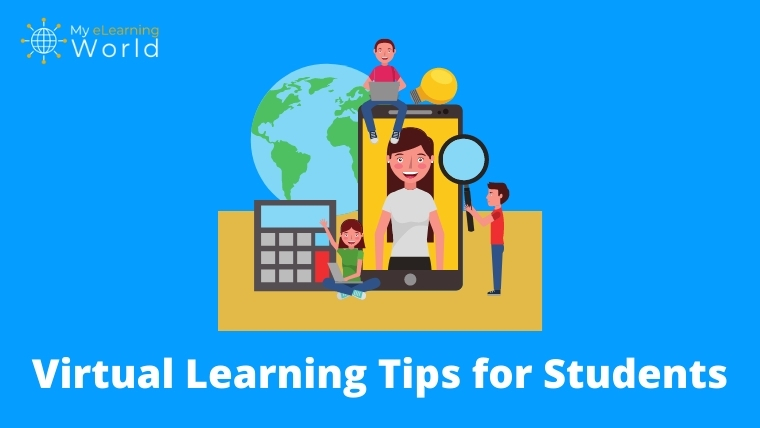The educational landscape has shifted radically in recent years. The idea that students have to be physically present in a classroom to learn was challenged when the world was turned upside down during the early days of the COVID-19 pandemic. Technology has taken virtual learning from a futuristic idea to a reality. In fact, the National Center for Education Statistics‘ most recent report found that 65% of all college students took at least one online class in 2021. Even some students in elementary and high school still attend some classes online.
As long as you have an internet connection, you can now access quality education from anywhere in the world.
But that’s not to say that virtual learning doesn’t have its own set of unique challenges. As a teacher of 20 years, I’ve seen firsthand that after spending several years learning in a physical classroom setting, the transition to virtual learning can prove difficult for some students, especially younger kids. They no longer have a live teacher in front of them, nor do they have a cohort of learners around them who can help and support them the same way they do in a real classroom.
With that in mind, here are some virtual learning tips for students I’ve found to be helpful for adjusting to an online learning environment:
1. Know the Expectations
One of the best online learning tips for students is to take the time to understand what exactly your teacher is looking for you to do.
Each teacher will have expectations in terms of note-taking, assignment completion, and attendance. Make sure you know what each teacher expects and attend each class prepared.
As a teacher who had to adjust to a new online learning environment, I’m asking you to have a degree of patience and understanding. While you might only be used to in-person learning, there’s a chance that your teacher is only used to that too. They might be trying to get used to virtual learning too.
As I experienced during the pandemic, there can be a learning curve for everyone involved, and things will be different for teachers and students alike.
2. Have the Proper Technology
Since you have to use your home computer or tablet, you will need to ensure that you have everything required and that it is working correctly. After all, 4.4 million students don’t even have consistent access to computers for virtual learning, and many more don’t have a stable internet connection.
So ask yourself the following questions:
- Is your laptop charged and/or plugged in?
- Is your internet connection running smoothly?
- Does your Zoom microphone work?
- Is the microphone sensitivity too high or does your microphone sound like a robot?
- What about your webcam?
I always advise students that it’s a good idea to sign on for class a few minutes early. That gives you time to have everything loaded and troubleshoot anything that does not appear to be working properly.
3. Prepare Your Learning Environment
Aside from having what you need in the technology department, some courses may also require other materials.
Here is a list of useful items to have within reach:
- Paper for taking notes (or a note taking app if you prefer)
- Pens and pencils
- Markers, crayons, or pencil crayons
- Highlighter
- Calculator
- Ruler
- Water bottle and a snack
Virtual learning for students will also require a study space that has adequate light, and that is comfortable. It is also a good idea to have an area that is free of outside distractions so you can stay focused and motivated to study.
4. Establish a Routine
Teachers who are providing virtual learning for students will stick to a schedule. They will most likely be available during a specific time slot each day. Though students will have to be online for any lectures and to ask questions, some of the allotted time may also be used for completing assigned work.
Now, instead of being in a class for 60-90 minutes, students may only need to be online for the first 15 minutes to attain the required information before logging off and completing assigned work.
It is essential to establish a routine so that the time teachers are allotting for classwork is not wasted. It is a good idea to follow a regular school day schedule as much as possible. Having a schedule will prevent students from falling behind and not completing the work on time.
If you feel like you are caught up or ahead in a course, use the time to work on other subjects, hold study sessions, and to get prepared for your next online session of the day.
5. Remember Your Daily Physical Activity (DPA)
DPA is still an essential part of the curriculum but can be challenging to deliver as an online program. And according to the World Health Organization, over 80% of kids don’t get enough exercise.
A Physical Education teacher may want online students to discuss rules of sports and techniques. Still, the onus is on these online students to remain physically active.
Here are some tips for virtual learning in Phys. Ed.:
- Get up from the computer between online classes to stretch out your body. Now that you are not moving from classroom to classroom, you may be more sedentary than usual.
- Go for a walk or jog.
- Have a trampoline? Get jumping!
- Use the basketball nets outside on the school grounds to shoot some hoops.
- Find a YouTube exercise channel you like and get moving.
- Play VR games that help you work up a sweat like Just Dance or Beat Sabers.
Physical activity helps to improve your mood, increase energy, and awaken your brain for learning so you perform better during your online classes.
6. Talk to Your Teachers
Any good teacher will still make themselves available for you when you have questions and need help with your work. Virtual learning for students and teachers will look and feel different, so it is vital to keep communication open.
Also, take it from me — your teacher may be looking at 20-30 students on their screen and may not notice if you have your hand up to ask a question.
Some online learning platforms have a virtual hand you can raise, or the teacher may have a signal that you are to use. Find out what the procedure is and if you have questions, make sure you ask!
If the teacher does not recognize you, turn on your mic and address them politely, and they will acknowledge you.
If you feel confident and don’t have any questions about the work, it is still important to maintain a connection when operating in a virtual environment.
At the end of class, ask your teacher how his weekend was or mention that you saw him walking his dog! Or tell a story about something that happened at your house. I know that we teachers miss that kind of communication with their students when doing distance learning, and it is an integral part of their day.
7. Talk to Your Classmates
Having the opportunity to talk to your classmates and maintain a certain level of socialization is also important to online learning success and well-being. Your teacher understands this as well and will provide opportunities for interaction when possible.
Another benefit to signing on earlier is that you may have an opportunity to socialize before the teacher is ready to begin the lesson. One of the most complex parts of remote learning is that the social aspect is not the same as in-person schooling.
Remember to remain engaged. If someone asks a question during class or posts to a discussion board, be prepared to participate and help to create dialogue.
You may also want to set up online study groups of smaller cohorts so that you have more opportunities to speak with your classmates. Group chats using social apps are also a great way to stay in touch.
8. Stay Focused During Virtual Teaching
As part of preparing your ideal distance learning environment, I mentioned that you need a quiet place with no distractions. Maintaining focus (and avoiding boredom!) can be one of the biggest challenges of virtual learning. Your teacher may not be able to see if you have other tabs open, your phone in your hand, or the television on.
You have to take greater responsibility for your learning now. One crucial tip for virtual learning is to leave your phone and other devices that could be distracting in another room.
If you find your mind wanders more easily when you do not physically have your teacher in front of you, take notes during the lecture. Even if printable notes are provided, it is a good learning strategy. Most people tend to absorb more information if they hear it and write it.
9. Set Measurable Goals
Virtual learning can be overwhelming at times. Setting clear and measurable goals can help alleviate some of the stress and anxiety that some may feel and set you on the path to online learning success.
If you have big, multifaceted assignments, break them into smaller, more manageable chunks. Create a schedule for each of the tasks working up to the due date.
It is a good idea to use a calendar to keep track of what you need to complete each day during your distance learning. Though a digital calendar will work, sometimes a visual representation is better for staying on track. When you have your work set out in front of you where it is visible, it seems to keep you more motivated to get it done.
I highly recommend checking out our guide on SMART goals for students as it can help you set reasonable, measurable goals.
10. Reward Yourself
It is important to be proud of your accomplishments. Virtual learning is not easy. It takes perseverance, motivation, patience, and grit. Set your goals for the week and reward yourself upon completion.
Working toward something will help you to maintain your focus and get the job done.
Aside from a good grade for doing your work and handing it in on time, do something special for yourself that will make you happy.
11. Remember the Fresh Air
It can be tiring for online learners to sit in front of a computer and not have the in-person socialization you are used to. Make sure you are taking brain breaks between your online classes and, if you can, get some fresh air and sunshine.
In fact, one survey found that 75% of educators believe students who “spend regular time outdoors are more creative and better problem solvers.”
Sitting in front of a screen all day doing distance learning can make you feel tired, and your mood may not be the greatest. Boost your mood by taking plenty of brain breaks!
Put These Virtual Learning Tips to Work!
These tips for virtual learning are just a few things that will help students transition from the classroom at school to the classroom at home.
I’m also a strong believer that students often need support from parents and others in the home to ensure that things run smoothly.
Some homes may have multiple students in different grades trying to participate in virtual learning simultaneously. Every family will need a system that will work in their home. The most important thing is to support one another and work as a team.
What are some other online learning tips for a successful school year? Share your thoughts by commenting below.



